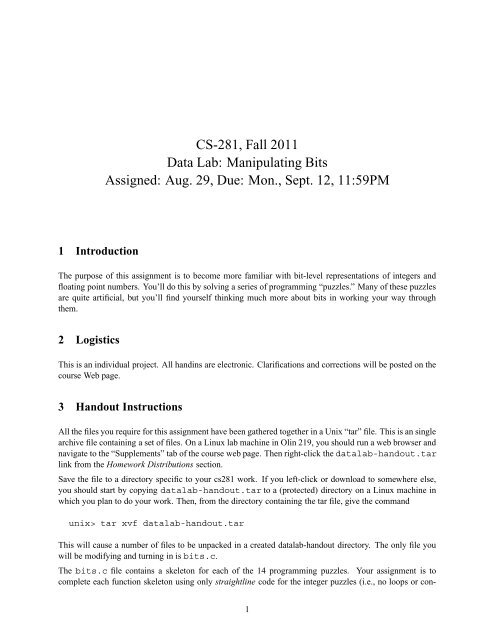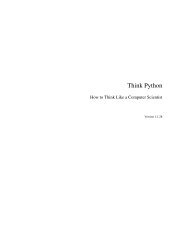CS-281, Fall 2011 Data Lab: Manipulating Bits Assigned: Aug. 29, Due
CS-281, Fall 2011 Data Lab: Manipulating Bits Assigned: Aug. 29, Due
CS-281, Fall 2011 Data Lab: Manipulating Bits Assigned: Aug. 29, Due
- No tags were found...
You also want an ePaper? Increase the reach of your titles
YUMPU automatically turns print PDFs into web optimized ePapers that Google loves.
<strong>CS</strong>-<strong>281</strong>, <strong>Fall</strong> <strong>2011</strong><strong>Data</strong> <strong>Lab</strong>: <strong>Manipulating</strong> <strong>Bits</strong><strong>Assigned</strong>: <strong>Aug</strong>. <strong>29</strong>, <strong>Due</strong>: Mon., Sept. 12, 11:59PM1 IntroductionThe purpose of this assignment is to become more familiar with bit-level representations of integers andfloating point numbers. You’ll do this by solving a series of programming “puzzles.” Many of these puzzlesare quite artificial, but you’ll find yourself thinking much more about bits in working your way throughthem.2 LogisticsThis is an individual project. All handins are electronic. Clarifications and corrections will be posted on thecourse Web page.3 Handout InstructionsAll the files you require for this assignment have been gathered together in a Unix “tar” file. This is an singlearchive file containing a set of files. On a Linux lab machine in Olin 219, you should run a web browser andnavigate to the “Supplements” tab of the course web page. Then right-click the datalab-handout.tarlink from the Homework Distributions section.Save the file to a directory specific to your cs<strong>281</strong> work. If you left-click or download to somewhere else,you should start by copying datalab-handout.tar to a (protected) directory on a Linux machine inwhich you plan to do your work. Then, from the directory containing the tar file, give the commandunix> tar xvf datalab-handout.tarThis will cause a number of files to be unpacked in a created datalab-handout directory. The only file youwill be modifying and turning in is bits.c.The bits.c file contains a skeleton for each of the 14 programming puzzles. Your assignment is tocomplete each function skeleton using only straightline code for the integer puzzles (i.e., no loops or con-1
ditionals) and a limited number of C arithmetic and logical operators. Specifically, you are only allowed touse the following eight operators:! ˜ & ˆ | + >A few of the functions further restrict this list; you can see the legal operators in the comments for eachfunction in bits.c. Also, you are not allowed to use any constants longer than 8 bits. See the commentsin bits.c for detailed rules and a discussion of the desired coding style.4 The PuzzlesThis section describes the puzzles that you will be solving in bits.c.4.1 Bit ManipulationsTable 1 describes a set of functions that manipulate and test sets of bits. The “Rating” field gives thedifficulty rating (the number of points) for the puzzle, and the “Max ops” field gives the maximum numberof operators you are allowed to use to implement each function. See the comments in bits.c for moredetails on the desired behavior of the functions. You may also refer to the test functions in tests.c. Theseare used as reference functions to express the correct behavior of your functions, although they don’t satisfythe coding rules for your functions.Name Description Rating Max OpsallEven<strong>Bits</strong>(x) return 1 iff all even numbered bits of x are set. 2 12bitMask(x,y) Yield mask of all 1s from bits x to y. 3 16bitXor(x,y) Compute xˆy using only ˜ and &. 1 14copyLSB() Generate word with all bits same as lsb of x. 2 5implication(x,y) Return propositional logic x ⇒ y. 2 5replaceByte(x,n,c) Replace byte n in x with c. 3 10Table 1: Bit-Level Manipulation Functions.4.2 Two’s Complement ArithmeticTable 2 describes a set of functions that make use of the two’s complement representation of integers. Again,refer to the comments in bits.c and the reference versions in tests.c for more information.5 EvaluationYour score will be computed out of a maximum of 62 points based on the following distribution:2
Name Description Rating Max OpsabsVal(x) Compute absolute value of x. 4 10addOK(x,y) Determine if can compute x+y without overflow 3 20divpwr2(x,n) Compute x/2 n 2 15fitsShort(x) Return 1 iff x can be represented in 16 bit two’s comp. 1 8isNotEqual(x,y) return 0 if x == y, and 1 otherwise 2 6isTmin(x) Return 1 iff x is the minimum twos complement integer. 1 10minusOne() Return -1. 1 2sign(x) return 1 if positive, 0 if zero, and -1 if negative 2 10Table 2: Arithmetic Functions<strong>29</strong> Correctness points.28 Performance points.5 Style points.Correctness points. The 14 puzzles you must solve have been given a difficulty rating between 1 and 4, suchthat their weighted sum totals to <strong>29</strong>. We will evaluate your functions using the btest program, which isdescribed in the next section. You will get full credit for a puzzle if it passes all of the tests performed bybtest, and no credit otherwise.Performance points. Our main concern at this point in the course is that you can get the right answer.However, we want to instill in you a sense of keeping things as short and simple as you can. Furthermore,some of the puzzles can be solved by brute force, but we want you to be more clever. Thus, for each functionwe’ve established a maximum number of operators that you are allowed to use for each function. This limitis very generous and is designed only to catch egregiously inefficient solutions. You will receive two pointsfor each correct function that satisfies the operator limit.Style points. Finally, we’ve reserved 5 points for a subjective evaluation of the style of your solutions andyour commenting. Your solutions should be as clean and straightforward as possible. Your comments shouldbe informative, but they need not be extensive.Autograding your workWe have included some autograding tools in the handout directory — btest, dlc, and driver.pl —to help you check the correctness of your work.• btest: This program checks the functional correctness of the functions in bits.c. To build anduse it, type the following two commands:unix> makeunix> ./btest3
Notice that you must rebuild btest each time you modify your bits.c file.You’ll find it helpful to work through the functions one at a time, testing each one as you go. You canuse the -f flag to instruct btest to test only a single function:unix> ./btest -f bitAndYou can feed it specific function arguments using the option flags -1, -2, and -3:unix> ./btest -f bitAnd -1 7 -2 0xfCheck the file README for documentation on running the btest program.• dlc: This is a modified version of an ANSI C compiler from the MIT CILK group that you can useto check for compliance with the coding rules for each puzzle. The typical usage is:unix> ./dlc bits.cThe program runs silently unless it detects a problem, such as an illegal operator, too many operators,or non-straightline code in the integer puzzles. Running with the -e switch:unix> ./dlc -e bits.ccauses dlc to print counts of the number of operators used by each function. Type ./dlc -helpfor a list of command line options.• driver.pl: This is a driver program that uses btest and dlc to compute the correctness andperformance points for your solution. It takes no arguments:unix> ./driver.plYour instructors will use driver.pl to evaluate your solution.6 Handin InstructionsThe only file I require from you is the bits.c file. At present, turning in your assignment simply involvessending the bits.c file to me as an attachment in an email. The send timestamp on the email will determineany lateness penalty, with anything after 11:59 pm on the due date either using one of your grace daysfor this assignment, or incurring the mandatory 10% penalty. (Likewise for subsequent 24 hour periods oflateness.)4
7 Advice• Don’t include the header file in your bits.c file, as it confuses dlc and results insome non-intuitive error messages. You will still be able to use printf in your bits.c file fordebugging without including the header, although gcc will print a warning that youcan ignore.• The dlc program enforces a stricter form of C declarations than is the case for C++ or that is enforcedby gcc. In particular, any declaration must appear in a block (what you enclose in curly braces) beforeany statement that is not a declaration. For example, it will complain about the following code:int foo(int x){int a = x;a *= 3; /* Statement that is not a declaration */int b = a; /* ERROR: Declaration not allowed here */}8 The “Beat the Prof” ContestFor fun, we’re offering an optional “Beat the Prof” contest that allows you to compete with other studentsand the instructor to develop the most efficient puzzles. The goal is to solve each <strong>Data</strong> <strong>Lab</strong> puzzle using thefewest number of operators. Students who match or beat the instructor’s operator count for each puzzle arewinners!To submit your entry to the contest, type:unix> ./driver.pl -u ‘‘Your Nickname’’Nicknames are limited to 35 characters and can contain alphanumerics, apostrophes, commas, periods,dashes, underscores, and ampersands. You can submit as often as you like. Your most recent submissionwill appear on a real-time scoreboard, identified only by your nickname. You can view the scoreboard bypointing your browser athttp://tashi:80805
















